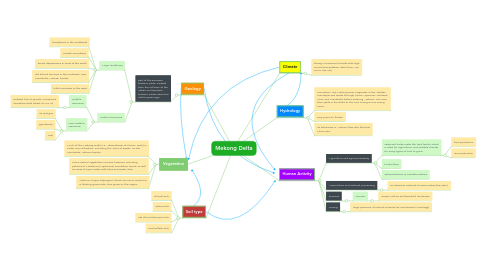
1. Vegetation
1.1. Much of the Mekong Delta (i.e., downstream of Phnom Penh) is under rice cultivation, including the 'Plain of Reeds' on the Cambodia-Vietnam border.
1.2. Some natural vegetation remains however, including patches of Melaleuca (Myrtaceae) inundation forest, as well as areas of open water with lotus and water lilies.
1.3. Wild rice (Oryza rufipogon), which can occur rooted or in floating grass mats, also grows in this region.
2. Geology
2.1. part of the Eurasian tectonic plate, created from the collision of the Indian and Eurasian tectonic plates about 50 million years ago.
2.1.1. Major landforms
2.1.1.1. floodplains in the northwest
2.1.1.2. coastal complexes
2.1.1.3. broad depressions in most of the south
2.1.1.4. old alluvial terraces in the northeast, near Cambodia-Vietnam border
2.1.1.5. hills/mountains in the west
2.1.2. Natural resources
2.1.2.1. Metallic resources
2.1.2.1.1. isolated hills of granite, occasional limestone (with tallest at 710 m)
2.1.2.2. Non-metallic resources
2.1.2.2.1. oil and gas
2.1.2.2.2. gemstones
2.1.2.2.3. coal
3. Soil type
3.1. alluvial soils
3.2. saline soils
3.3. old alluvial (terrace) soils
3.4. acid-sulfate soils
4. Hydrology
4.1. Formation: The Mekong River originates in the Tibetan Himalayas and winds through China, Myanmar, Thailand, Laos, and Cambodia before entering Vietnam. The river then splits in the delta to the Tien Giang & Hau Giang rivers.
4.2. very prone to floods,
4.3. its tributaries in Vietnam flow into the East China Sea.
5. Climate
5.1. strong, monsoonal climate with high annual precipitation rates (from 150 cm to 235 cm)
6. Human Activity
6.1. Agriculture and agro-processing
6.1.1. sediment helps make the land fertile, which is ideal for agriculture, and suitable climate for many types of fruit to grow.
6.1.1.1. fruit production
6.1.1.2. rice production
6.1.2. horticulture
6.1.3. salt production in coastal marshes
6.2. Aquaculture and seafood processing
6.2.1. an intensive network of rivers makes this ideal.
6.3. Services
6.3.1. Tourism
6.3.1.1. unique culture and beautiful landscape
6.4. Mining
6.4.1. large presence of natural minerals (as mentioned in Geology)
